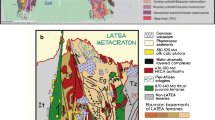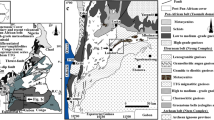Abstract
Four massif-type anorthosite bodies 25–100 km2 in area occur within high-pressure granulite facies supracrustal gneisses in southwestern Madagascar. Two of these bodies (Ankafotia and Saririaky) appear to have been pulled apart by 40 km in a ductile shear zone, but structural features such as sub-vertical stretching lineations indicate an origin by intense west-directed flattening and pure shear. Country rocks (Graphite Series) include abundant graphite schist (some with >60% graphite), marble, quartzite, and minor amphibolite and leucogneiss. Comagmatic granitoids (e.g. charnockites) are conspicuously absent. The anorthosite bodies are dominated by coarse grained anorthosites and leuconorites (feldspars typically 3–5 cm, up to 1 m); minor norites and oxide-rich ferrogabbros occur near the margins, but ultramafic rocks are absent. Typical mineralogy of the anorthositic rocks is: plagioclase (An41–54) + orthopyroxene (En38–66) ± augite (Mg♯ = 32–68) ± ilmenite ± magnetite ± apatite. High-alumina (to 6.1 wt% Al2O3) orthopyroxene megacrysts are widespread; most have exsolutions of calcic plagioclase (An72–85) but some contain garnet lamellae. Metamorphism has produced abundant recrystallization and sporadic coronitic garnet (Mg ♯=12–36) + clinopyroxene assemblages. Rb-Sr isotopic analyses of whole-rocks and minerals reveal no meaningful age relationships. The age of late Neoproterozoic metamorphism is best constrained at 559 ± 50 Ma by a 6-point Sm-Nd mineral isochron (whole rock, plag, pyx, ilm, apat, gar) from a Saririaky oxide-rich gabbro. The igneous crystallization age of the anorthosites is estimated at 660 ± 60 Ma by a 19-point combined whole-rock and mineral Sm-Nd isochron for samples from both the Ankafotia and Saririaky bodies. Initial isotopic ratios calculated at 0.66 Ga among 13 whole rocks are: Nd=+2.6 to +5.2 (mean=+3.7) and ISr=0.70328–0.70407 (mean=0.70347), indicating derivation of the Malagasy anorthosites from a depleted mantle source, and little, if any, contamination with Archean crustal material. One anorthosite sample with Nd=−1.4 and ISr=0.70344 (calculated at 0.66 Ga) probably reflects the effects of assimilation of Early to Middle Proterozoic crustal basement, but typical surrounding graphite schist (Nd=+0.3, ISr=0.70636, both at 0.66 Ga; TDM= 1131 Ma) represents only a minor potential contaminant for the anorthosite bodies. TDM model ages of the Malagasy anorthosites (797–1280 Ma; mean of 14 samples=949 Ma), as those of most other massif-type anorthosites, are older than the true crystallization age, because of crustal contamination effects. Our isotopic data, together with recent U-Pb data from the anorthosites and surrounding country rocks, are consistent with emplacement of the Malagasy anorthosite bodies at or before the start of a protracted, high-grade metamorphic event or series of events between about 630 and 550 Ma. This period coincides with the collision between, and amalgamation of, East and West Gondwana.
Similar content being viewed by others
Author information
Authors and Affiliations
Additional information
Received: 19 December 1997 / Accepted: 12 June 1998
Rights and permissions
About this article
Cite this article
Ashwal, L., Hamilton, M., Morel, V. et al. Geology, petrology and isotope geochemistry of massif-type anorthosites from southwest Madagascar. Contrib Mineral Petrol 133, 389–401 (1998). https://doi.org/10.1007/s004100050461
Issue Date:
DOI: https://doi.org/10.1007/s004100050461




